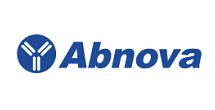NEFL & APP Protein Protein Interaction Antibody Pair



* The price is valid only in USA. Please select country.
-
More Files
- More Functions
-
Specification
Product Description
This protein protein interaction antibody pair set comes with two antibodies to detect the protein-protein interaction, one against the NEFL protein, and the other against the APP protein for use in in situ Proximity Ligation Assay. See Publication Reference below.

Reactivity
Human
Quality Control Testing
Protein protein interaction immunofluorescence result.
Representative image of Proximity Ligation Assay of protein-protein interactions between NEFL and APP. HeLa cells were stained with anti-NEFL rabbit purified polyclonal antibody 1:1200 and anti-APP mouse monoclonal antibody 1:50. Each red dot represents the detection of protein-protein interaction complex. The images were analyzed using an optimized freeware (BlobFinder) download from The Centre for Image Analysis at Uppsala University.
Supplied Product
Antibody pair set content:
1. NEFL rabbit purified polyclonal antibody (100 ug)
2. APP mouse monoclonal antibody (40 ug)
*Reagents are sufficient for at least 30-50 assays using recommended protocols.Storage Instruction
Store reagents of the antibody pair set at -20°C or lower. Please aliquot to avoid repeated freeze thaw cycle. Reagents should be returned to -20°C storage immediately after use.
-
Applications
In situ Proximity Ligation Assay (Cell)
-
Gene Info — APP
Entrez GeneID
351Gene Name
APP
Gene Alias
AAA, ABETA, ABPP, AD1, APPI, CTFgamma, CVAP, PN2
Gene Description
amyloid beta (A4) precursor protein
Gene Ontology
HyperlinkGene Summary
This gene encodes a cell surface receptor and transmembrane precursor protein that is cleaved by secretases to form a number of peptides. Some of these peptides are secreted and can bind to the acetyltransferase complex APBB1/TIP60 to promote transcriptional activation, while others form the protein basis of the amyloid plaques found in the brains of patients with Alzheimer disease. Mutations in this gene have been implicated in autosomal dominant Alzheimer disease and cerebroarterial amyloidosis (cerebral amyloid angiopathy). Multiple transcript variants encoding several different isoforms have been found for this gene. [provided by RefSeq
Other Designations
A4 amyloid protein|amyloid beta A4 protein|amyloid-beta protein|beta-amyloid peptide|cerebral vascular amyloid peptide|peptidase nexin-II|protease nexin-II
-
Gene Info — NEFL
Entrez GeneID
4747Gene Name
NEFL
Gene Alias
CMT1F, CMT2E, FLJ53642, NF-L, NF68, NFL
Gene Description
neurofilament, light polypeptide
Gene Ontology
HyperlinkGene Summary
Neurofilaments are type IV intermediate filament heteropolymers composed of light, medium, and heavy chains. Neurofilaments comprise the axoskeleton and they functionally maintain the neuronal caliber. They may also play a role in intracellular transport to axons and dendrites. This gene encodes the light chain neurofilament protein. Mutations in this gene cause Charcot-Marie-Tooth disease types 1F (CMT1F) and 2E (CMT2E), disorders of the peripheral nervous system that are characterized by distinct neuropathies. A pseudogene has been identified on chromosome Y. [provided by RefSeq
Other Designations
light molecular weight neurofilament protein|neurofilament protein, light chain|neurofilament subunit NF-L|neurofilament triplet L protein|neurofilament, light polypeptide 68kDa|neurofilament-light
-
Interactome
-
Pathway
-
Disease
- +1-909-264-1399
+1-909-992-0619
Toll Free : +1-877-853-6098 - +1-909-992-3401
- sales@abnova.com


















